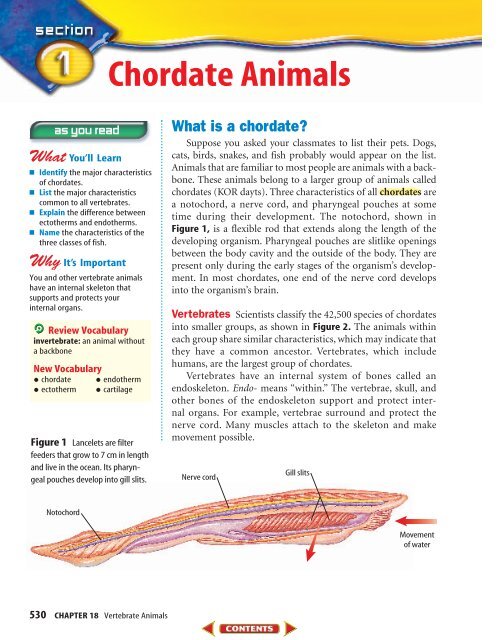Chapter 18: Vertebrate Animals
Chapter 18: Vertebrate Animals
Chapter 18: Vertebrate Animals
You also want an ePaper? Increase the reach of your titles
YUMPU automatically turns print PDFs into web optimized ePapers that Google loves.
Chordate <strong>Animals</strong><br />
■ Identify the major characteristics<br />
of chordates.<br />
■ List the major characteristics<br />
common to all vertebrates.<br />
■ Explain the difference between<br />
ectotherms and endotherms.<br />
■ Name the characteristics of the<br />
three classes of fish.<br />
You and other vertebrate animals<br />
have an internal skeleton that<br />
supports and protects your<br />
internal organs.<br />
Review Vocabulary<br />
invertebrate: an animal without<br />
a backbone<br />
New Vocabulary<br />
• chordate<br />
ectotherm<br />
• endotherm<br />
cartilage<br />
Figure 1 Lancelets are filter<br />
feeders that grow to 7 cm in length<br />
and live in the ocean. Its pharyngeal<br />
pouches develop into gill slits.<br />
What is a chordate<br />
Suppose you asked your classmates to list their pets. Dogs,<br />
cats, birds, snakes, and fish probably would appear on the list.<br />
<strong>Animals</strong> that are familiar to most people are animals with a backbone.<br />
These animals belong to a larger group of animals called<br />
chordates (KOR dayts). Three characteristics of all chordates are<br />
a notochord, a nerve cord, and pharyngeal pouches at some<br />
time during their development. The notochord, shown in<br />
Figure 1, is a flexible rod that extends along the length of the<br />
developing organism. Pharyngeal pouches are slitlike openings<br />
between the body cavity and the outside of the body. They are<br />
present only during the early stages of the organism’s development.<br />
In most chordates, one end of the nerve cord develops<br />
into the organism’s brain.<br />
<strong>Vertebrate</strong>s Scientists classify the 42,500 species of chordates<br />
into smaller groups, as shown in Figure 2. The animals within<br />
each group share similar characteristics, which may indicate that<br />
they have a common ancestor. <strong>Vertebrate</strong>s, which include<br />
humans, are the largest group of chordates.<br />
<strong>Vertebrate</strong>s have an internal system of bones called an<br />
endoskeleton. Endo- means “within.” The vertebrae, skull, and<br />
other bones of the endoskeleton support and protect internal<br />
organs. For example, vertebrae surround and protect the<br />
nerve cord. Many muscles attach to the skeleton and make<br />
movement possible.<br />
Nerve cord<br />
Gill slits<br />
Notochord<br />
Movement<br />
of water<br />
530 CHAPTER <strong>18</strong> <strong>Vertebrate</strong> <strong>Animals</strong>

















